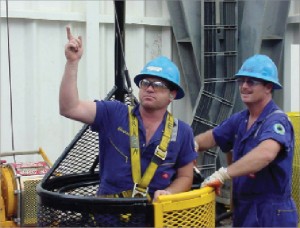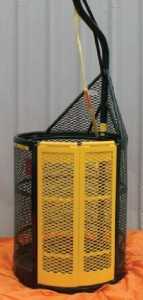Contractor, vendor team up to improve training, fall protection, strength of derrick-riding basket
By Katie Mazerov, contributing editor

Collaboration is a beautiful thing, especially when it extends beyond the parties involved to create a standard of practice for a safer workplace.
Such a meeting of the minds occurred earlier this year when Atwood Oceanics recognized a need to reduce risk in the use of the man-riding derrick basket being deployed on its rigs. Atwood approached the Billy Pugh Company, manufacturer of the DB-1 derrickman riding basket, about re-analyzing the unit and developing additional protocols and support materials for proper use of the equipment. The aim was to ensure a higher level of safety for what is a necessary but potentially dangerous aspect of offshore drilling.
“This was quite a collaborative effort,” said John Gidley, director, health, safety and environment for Atwood Oceanics.
“We wanted to see if there were some design opportunities that would make the basket stronger, and also improve communication about how the product should and should not be used, bearing in mind this is the oilfield, where people are working in challenging, often dirty, conditions. Through this process, we established a link of recognizing the hazards, understanding and reducing the risk and communicating those messages to our workers.”
Developed some years ago after two fatal accidents involving man-riding in the derrick, the DB-1 basket is designed for use inside a derrick, providing support for workers doing maintenance. The device replaced the traditional method of derrick-riding, which typically involved a worker outfitted in a full-body harness or seated in boatswain chair, attached to a tugger line that moved up and down.
That system was problematic because it offered no outer protection for the worker and no place for the worker to keep tools. In addition, workers experienced leg circulation problems because of the extended periods of time they were in a seated position.
The DB-1 system features a cone-shaped aluminum basket weighing 105 lbs that is attached to an air tugger, a lifting device designed for light loads, at a single-point hookup. The basket provides outer protection for the worker and allows the tools to move with the worker.
In embarking on the improved design, Atwood Oceanics and the Billy Pugh Company did an engineering analysis and produced a number of ways the system could be safer, not the least of which was education.
“We realized the product could have had more safety and instructional material to go with it to ensure that people were using it properly,” said Paul Liberato, president of the Billy Pugh Company. “You can have a great product, but if people aren’t educated on the proper use and benefits of it, you’re missing a key component. So, with our expertise with the product design and Atwood’s perspective as a drilling contractor that uses it in the field, we decided to go back and take a second look to see how we could improve the DB-1 program.”
What resulted was a recommended practices document that makes clear the hazards of derrick man-riding and outlines specific procedures for using the equipment properly. Among the recommendations are that only qualified, trained personnel should use the basket, and that workers wear secondary fall protection gear, such as a full-body harness attached to a retractable lifeline.
“As the basket moves up and down with the tugger, the retractable lifeline moves up and down with it,” Mr Liberato explained. “This way, if there is a failure or if something gives way, the worker won’t fall. He is protected in a variety of safety redundancies, making man-riding in the derrick a much safer procedure for our customers in the drilling business.”
The document establishes minimum training requirements, inspection procedures, and operational and administrative practices. It also specifies how the equipment is not to be used.

“There’s a very specific method for using this piece of equipment,” Mr Liberato said. “For example, this is not a work basket to be used on the outside of the rig. And this is not something to be hooked onto a crane, which is designed to lift several tons. We also make specific equipment for these general man-riding tasks, but the DB-1 is very specialized for the job it does. And that job is moving folks safely up and down in the derrick.”
An added feature of the new design is a nylon sling that can catch the basket with the worker inside, providing yet another secondary means of protection. Finally, Billy Pugh increased the strength of the basket itself by 15%, thus raising the safety factor from 10-to-1 to 12-to-1, Mr Liberato noted.
Billy Pugh also prepared a training video to accompany the written recommendations and, with the help of Atwood, produced new signs, affixed on the equipment like stickers, stating key specifications and warning against improper use of the derrick basket.
“We’re an international drilling company, and our employees speak many languages,” Mr Gidley pointed out. “We needed these signs to be visible, large and very clear, communicating key messages that the workers need to know.”
The messages specify the equipment is not to be used with a crane; the weight of the basket; the safe working load; the need for a safety line at all times when in use.
The design improvements and enhanced communication of the DB-1 have allowed the system to have what Mr Gidley calls “a wider safety envelope” when it is deployed. “The oilfield attracts get-it-done kind of people who are motivated toward action,” he said. “But, we also need to understand that there are limitations to what we can do and how we use equipment.
“Collaboration isn’t necessarily a word that is used much in our industry between vendors and their clients,” he continued. “But in this case it worked because both companies were able to come to the table and bounce ideas back and forth, and saw this as an opportunity to make something better that hopefully will benefit the entire industry.”




